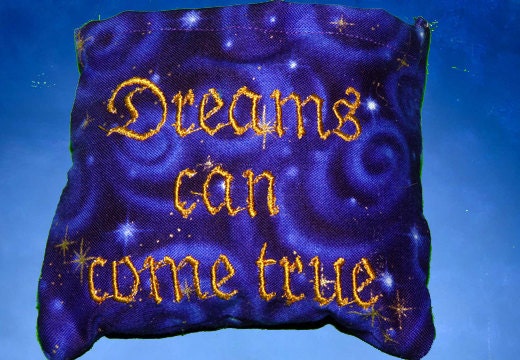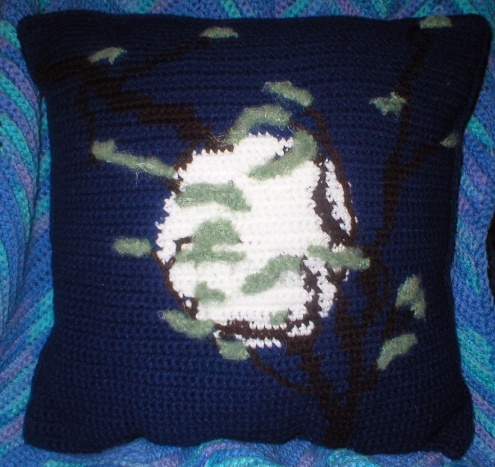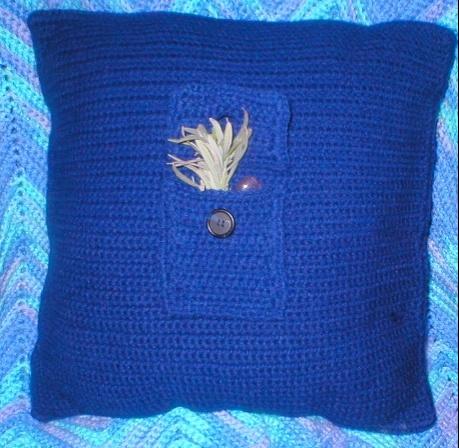 Submitted by PALLAS ATHENA -... on
Submitted by PALLAS ATHENA -... on

Every question has an answer. Every problem has a solution. Every soul knows the direction of its path. This empowering and all encompassing knowledge lives in the collective “inner mind” realms of the universal unconscious.
This realm of knowledge is accessible to anyone at anytime. The proof of this accessibility is most often seen when we are performing the tasks (like showering, crafting, walking, etc.) that encourage the mind to relax and detach from the “goings on” of the physical plane. This is the mind state that ushers in those incidental “ah ha” moments of inspiration. This is the mind state that transcends the ego imposed, limiting “I can’ts” of the conscious mind.
Transforming the incidental moments of “ah ha” into the intentional periods of “oh, wow, AH HA” can be as simple as vision questing during meditation and during the dream (and pre-dream) states of our sleep.
Everyone dreams. Even if not remembered, dreams are a consistent occurrence in our nocturnal life. Dreams can be rich in caricature and symbolism, or they can be as vivid as today’s waking events. Regardless of their seemingly superficial content, dreams carry the messages of the collective unconscious. Any mundane intent and action that honors the dream state increases the clarity and the flow of these “AH HA” messages.
Dream pillows have been used for centuries. By using a blend of specific herbs and flowers one is said to be able to experience vivid and meaningful dreams as well as receive relief from nightmares. Today we acknowledge the research that proves the smell of herbs, flowers and essential oils can have a positive effect on our ability to relax, mental health, and our dreams.
Historically, babies were often given small pillows filled with herbs to help calm them or to ease crying during the bedtime hours. They have also been called sleep or comfort pillows, and they were filled with relaxing herbs.
The scent of the herbs in these dream pillows will not be as strong as a potpourri, it will definitely be more subtle. The hope is that they will promote a more restful sleep and ward off bad dreams. If you, or someone you know, has trouble sleeping when traveling, bring a dream pillow with you to as a sleep aid.
Variety of Herbs Useful for Dream Pillows
- Anise – Repels nightmares, but be sure to use sparingly.
- Calendula – Used to induce restful sleep.
- Catnip - Increases restful sleep. Especially good for babies and children.
- Cedar – Repels bad dreams.
- Chamomile – Used for relaxation and pleasant dreams.
- Hops – Aids in restful sleep and healing.
- Jasmine – The dried flowers are useful for romantic and erotic dreams, especially for women.
- Lavender – These flowers have the ability to ease stress, soothe, and relax. A simple pillow made only with lavender can be simply perfect.
- Lemon Balm – A known for it’s ability to reduce anxiety and insomnia. Also valuable for relieving headaches and stress.
- Mugwort - Protection.
- Mullein – Guards against nightmares.
- Rose petals – Adds loving and peaceful thoughts to dreams.
- Rosemary - Repels bad dreams, but use sparingly due to the strong scent.
Creating Small Pillows
If you are handy with a sewing machine you can easily make small pillows or sachets from various fabrics or you could even make animal shapes that are stuffed with your own herb mixture to give as gifts for children. You could also sew these easily by hand with a simple stitch.
To make a dream pillow, I prefer to use muslin. Begin by cutting 2 identical sizes of fabric. I like these pieces of muslin to be 5″ by 5″ (Although any size will do. It’s a matter of preference). With the wrong sides of the material (if there are any) together, stitch down 3 of the sides to the depth of 3/4″. Turn the little sachet inside out so that the seams are now on the inside. Begin filling your sachet with your own herbal mixture or fill it with my favorite recipe below. Once filled to your liking, complete the pillow by stitching the fourth side by hand.
Dream Pillow Recipe – For Peaceful Sleep
- 1 part lavender flowers
- 1 part rose petals
- 1 part chamomile
- 1 part mugwort
- 1 part hop flowers
- 1 part cedar tops
- a small amount of rosemary
Directions: Combine all herbs in wooden or glass bowl and mix with a wooden spoon. Fill small, hand-sewn pillows with enough of this herbal mixture. Note: Be sure not to overfill. The sachet should go unnoticed slipped inside the pillow case.
Tips:
-Dream pillows help you drift off to sleep naturally. Simply insert a dream pillow inside of your pillow case.
-If using dream pillow with babies, you should place the pillow under the crib sheet to avoid a choking hazard.
-The herbs in the pillow will maintain their scent for years. You may want to store them in plastic bags when you are not using them to maintain the scent longer.
-Organically grown flowers and herbs are preferred for dream pillows.
-A few herbs you may want to avoid, secondary to their ability to cause frightening dreams and/or headaches, include: artemisia, bay laurel leaves, Russian tarragon, sage leaves, tansy, and vetiver root.
Crochted Pillow:
This pillow is approximately a square thirteen inches and bears a full moon design (that symbolically shines light on the knowledge of the ancients) on the front side.

The back side of this pillow has a small pocket that can hold gemstones, herbs, written intent, runes, or any item that carries the intent of your quest.

To make this pillow you will want to gather two skeins of background color worsted weight yarn, and one skein of each the moon and the tree color in worsted weight yarn, and a size “E” crochet hook. The addition of the leaves can entail the use of worsted weight yarn and/or the use of novelty yarn or thread. The use of the worsted weight yarn makes a very dense leaf grouping while the use of a size 10 thread makes the leaves very light and lacy. Novelty “fuzz” yarn was used to make the leaves in the model pillow. You will also want to have fiberfill, a large eye needle, and a 7/8 inch button with sewing needle and thread to complete the project.
Creating this pillow involves crochet and the magic of intent. The magic is created in both the selection of materials and the focused intent as you work each stitch. Additional materials that you can add include herbs or gemstones to the fiberfill and charms to the branches of the trees. You can choose the leaf color depending on the attributes of the seasons that will empower the magic of your intent.
The stitches that you will use in this pillow are a chain (ch), single crochet (sc), slip stitch (slpst) and half double crochet (hdc). The additional branches and leaves are made using a surface stitch crochet. This stitch is created much like a slip stitch that is worked from the front to the back of the crocheted piece. Place the piece with the right side facing you. The yarn is placed underneath the piece and held in place by your “yarn holding hand.” You insert the crochet hook in the fabric of single crochet and pick up (or yarn over) the yarn. Draw the strand back through the fabric piece to the right side. Insert the hook into the next desired stitch, yarn over the hook and draw the loop back through the piece and through the existing loop on the hook.
You will also be working from a graph. Each block of this graph represents one single crochet stitch. The odd numbered rows are worked from right to left and represent the “right” or presentation side of the fabric. The even numbered rows are worked from left to right and represent the non-public or “wrong” side of the fabric. The unmarked squares belong to the background color yarn. The squares with the diagonal slash mark the placement of the tree color yarn and the dots make up the squares of the moon color yarn. To change color, work the stitch just prior to the change to the last step, change color, and complete the stitch. Carry the unused yarn to the wrong side of the work. As you may not want to carry several strands of yarn at one time, you can create small bobbins of yarn by winding “butterflies” over your index finger and thumb. Hold the yarn secure with a twist tie. You will want to weave in the ends using your large eye needle as needed.
Focus your intent of questing for knowledge with each stitch that you are about to take.
- Begin the pattern by chaining 66.
- Work a single crochet in the second chain from the hook and in each chain across. This will leave you with 65 single crochets completed in row one.
- Work row two through 65 following the chart. Cut and fasten off your yarn.
- Add the leaf embellishments as you choose.
- Begin the back of the pillow as you did with the front through row one.
- Work one single crochet in each single crochet in each row from rows two through 65. Cut and fasten off your yarn.
- For the back pocket, chain 14.
- Single crochet in the second chain from the hook and in each chain across for 13 single crochets.
- Begin row two with a chain two, (which will count as the first hdc in this and the next seven rows.) Work a hdc in each sc across for a total of 13 stitches.
- Work rows three through nine as you did row two.
- Begin rows 10 and 11 with a chain one.
- Work one single crochet in each stitch across.
- At the end of row 11, chain One and make two sc in the last stitch of row 11.
- Evenly space 18 sc along long side of pocket to bottom corner. Work three sc in the bottom corner. E
- venly space 11 sc along bottom to opposite corner and work three sc in that corner.
- Evenly space 18 sc along long side to top corner and work three sc in that corner.
- Evenly space 11 sc along top side to corner and sc in that corner.
- Join to beginning sc with a slpst.
- Cut and fasten off yarn.
- Make the pocket flap by chaining 14.
- Work a single crochet in the second ch from the hook and in each ch across for 13 stitches for row one.
- Begin row two with a ch one. Work one single crochet in each single crochet across.
- Begin row three with a ch two (this counts as the first hdc now and for the rest of the pattern). Work a hdc in each stitch across.
- Begin row four with a ch two, Work hdc in next four stitches.
- Chain three.
- Skip three stitches.
- Hdc in next five stitches. This creates the button hole.
- Rows five through seven begin with a ch two. Work hdc in each stitch across (work three hdc in the ch three of row four).
- Rows eight and nine begin with a chain one.
- Work one single crochet in each stitch across.
- At the end of row nine, chain one and work two sc in the same stitch.
- Evenly space eight sc along the side to the bottom corner.
- Work three sc in the bottom corner.
- Evenly space 11 sc along bottom to opposite corner. Work three sc in that corner.
- Evenly space eight sc along side to top corner and work three sc in the top corner.
- Evenly space 11 sc to last corner.
- Work one sc in that corner and join to beginning sc with a slpst. Cut and fasten thread.
- Place the pocket and flap in the center of the pillow back. Using the background color yarn and the large eye needle, whipstitch the pocket and flap secure.
- Using the sewing needle and thread, secure the button in place.
- Hold pillow front and back together with right sides facing out.
- Join the yarn with a slpst at any corner.
- Ch one and work two sc in the same stitch as joining.
- Work 63 single crochets along the side to the next corner, work three sc in the corner.
- Repeat the 63 single crochets and the three sc corners until one side remains open.
- Stuff the pillow with the fiberfill and single crochet the final side to the corner.
- Work one sc in this corner and join to beginning sc with a slpst.
To begin your quest, focus on your question or desire. Place either your written intent or a symbol of your intent in the pillow pocket. State these or similar words, “The knowledge that I seek is given in dreams tonight. The darkness yields to wisdom’s light.” Ask that you be a partner in your dreams and that you remember the content of your dreams.
If your dream pillow aids in your physical comfort, place it as you would your normal pillow.If it seems uncomfortable, place the pillow under your regular pillow.
Use meditation techniques to relax your mind and body.
As you work with your dreams, you may begin to recognize a hypnogogic state that borders between wakefulness and sleep. This period is generally heralded by vivid sensory perceptions. As you learn to recognize this state, you can remain “asleep but aware” during this phase and enter a lucid dream state where you become an active (asleep but aware) participant in the dream. This enhanced awareness allows you to more actively direct the content of the dream, and can provide more of a direct route to the knowledge or the vision of your quest.
As with the development of any skill, the messages of the dream may take time to manifest in conscious memory. Even as they manifest to consciousness, the initial snippets of dream memory may be rich in caricature and may be comprised of (seemingly) nonsensical events that are difficult to understand. Allow yourself patience. Allow yourself a few moments prior to leaving your bed to journal these snippets of dream recall. Trust that the subconscious mind misses nothing. Your conscious memory may not recall or make sense of the dream, but your subconscious will know the intent of your quest and the answers to your questions that were revealed by your quest. Trust that those incidental “ah ha’s” of inspiration will amplify to the intentional “oh WOW, AH HA’s” that is the knowledge of the collective universal mind—the knowledge that you have quested for and found in the mind of your dreams and visions.
Resources:
- 4680 reads